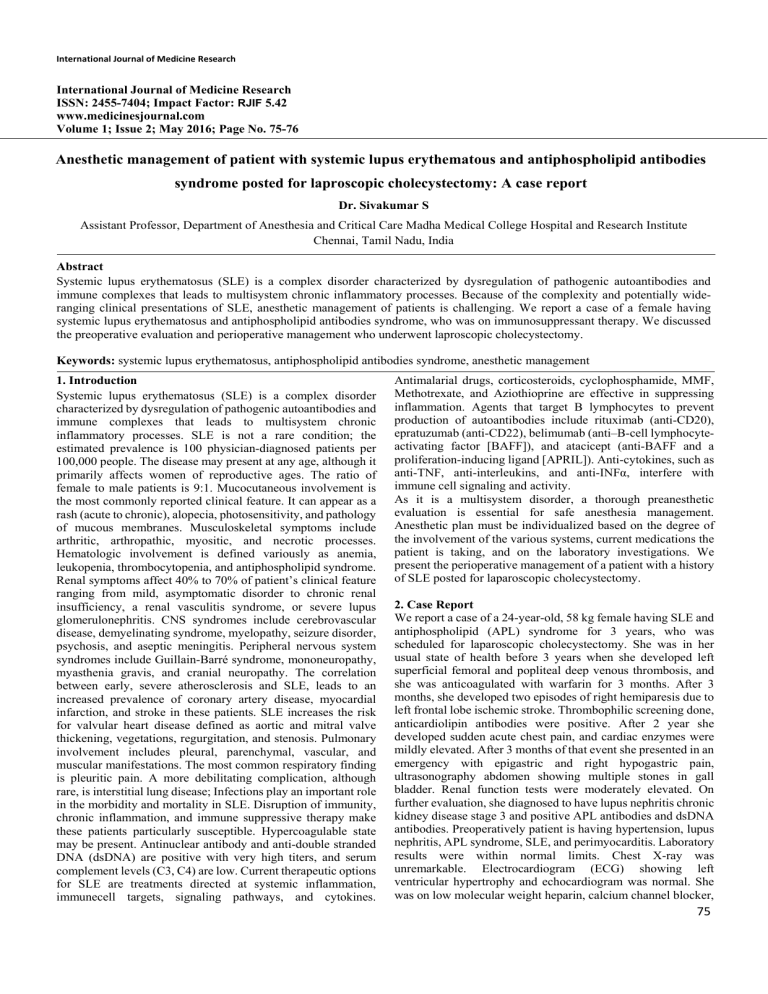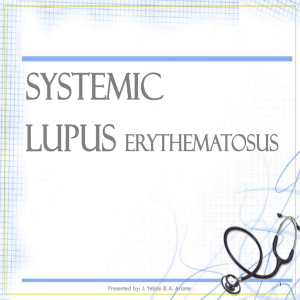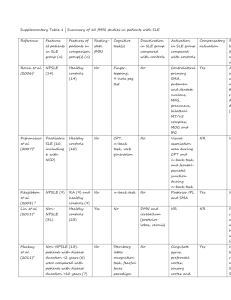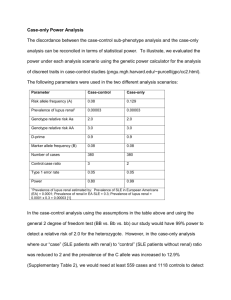
International Journal of Medicine Research International Journal of Medicine Research ISSN: 2455-7404; Impact Factor: RJIF 5.42 www.medicinesjournal.com Volume 1; Issue 2; May 2016; Page No. 75-76 Anesthetic management of patient with systemic lupus erythematous and antiphospholipid antibodies syndrome posted for laproscopic cholecystectomy: A case report Dr. Sivakumar S Assistant Professor, Department of Anesthesia and Critical Care Madha Medical College Hospital and Research Institute Chennai, Tamil Nadu, India Abstract Systemic lupus erythematosus (SLE) is a complex disorder characterized by dysregulation of pathogenic autoantibodies and immune complexes that leads to multisystem chronic inflammatory processes. Because of the complexity and potentially wideranging clinical presentations of SLE, anesthetic management of patients is challenging. We report a case of a female having systemic lupus erythematosus and antiphospholipid antibodies syndrome, who was on immunosuppressant therapy. We discussed the preoperative evaluation and perioperative management who underwent laproscopic cholecystectomy. Keywords: systemic lupus erythematosus, antiphospholipid antibodies syndrome, anesthetic management 1. Introduction Systemic lupus erythematosus (SLE) is a complex disorder characterized by dysregulation of pathogenic autoantibodies and immune complexes that leads to multisystem chronic inflammatory processes. SLE is not a rare condition; the estimated prevalence is 100 physician-diagnosed patients per 100,000 people. The disease may present at any age, although it primarily affects women of reproductive ages. The ratio of female to male patients is 9:1. Mucocutaneous involvement is the most commonly reported clinical feature. It can appear as a rash (acute to chronic), alopecia, photosensitivity, and pathology of mucous membranes. Musculoskeletal symptoms include arthritic, arthropathic, myositic, and necrotic processes. Hematologic involvement is defined variously as anemia, leukopenia, thrombocytopenia, and antiphospholipid syndrome. Renal symptoms affect 40% to 70% of patient’s clinical feature ranging from mild, asymptomatic disorder to chronic renal insufficiency, a renal vasculitis syndrome, or severe lupus glomerulonephritis. CNS syndromes include cerebrovascular disease, demyelinating syndrome, myelopathy, seizure disorder, psychosis, and aseptic meningitis. Peripheral nervous system syndromes include Guillain-Barré syndrome, mononeuropathy, myasthenia gravis, and cranial neuropathy. The correlation between early, severe atherosclerosis and SLE, leads to an increased prevalence of coronary artery disease, myocardial infarction, and stroke in these patients. SLE increases the risk for valvular heart disease defined as aortic and mitral valve thickening, vegetations, regurgitation, and stenosis. Pulmonary involvement includes pleural, parenchymal, vascular, and muscular manifestations. The most common respiratory finding is pleuritic pain. A more debilitating complication, although rare, is interstitial lung disease; Infections play an important role in the morbidity and mortality in SLE. Disruption of immunity, chronic inflammation, and immune suppressive therapy make these patients particularly susceptible. Hypercoagulable state may be present. Antinuclear antibody and anti-double stranded DNA (dsDNA) are positive with very high titers, and serum complement levels (C3, C4) are low. Current therapeutic options for SLE are treatments directed at systemic inflammation, immunecell targets, signaling pathways, and cytokines. Antimalarial drugs, corticosteroids, cyclophosphamide, MMF, Methotrexate, and Aziothioprine are effective in suppressing inflammation. Agents that target B lymphocytes to prevent production of autoantibodies include rituximab (anti-CD20), epratuzumab (anti-CD22), belimumab (anti–B-cell lymphocyteactivating factor [BAFF]), and atacicept (anti-BAFF and a proliferation-inducing ligand [APRIL]). Anti-cytokines, such as anti-TNF, anti-interleukins, and anti-INFα, interfere with immune cell signaling and activity. As it is a multisystem disorder, a thorough preanesthetic evaluation is essential for safe anesthesia management. Anesthetic plan must be individualized based on the degree of the involvement of the various systems, current medications the patient is taking, and on the laboratory investigations. We present the perioperative management of a patient with a history of SLE posted for laparoscopic cholecystectomy. 2. Case Report We report a case of a 24-year-old, 58 kg female having SLE and antiphospholipid (APL) syndrome for 3 years, who was scheduled for laparoscopic cholecystectomy. She was in her usual state of health before 3 years when she developed left superficial femoral and popliteal deep venous thrombosis, and she was anticoagulated with warfarin for 3 months. After 3 months, she developed two episodes of right hemiparesis due to left frontal lobe ischemic stroke. Thrombophilic screening done, anticardiolipin antibodies were positive. After 2 year she developed sudden acute chest pain, and cardiac enzymes were mildly elevated. After 3 months of that event she presented in an emergency with epigastric and right hypogastric pain, ultrasonography abdomen showing multiple stones in gall bladder. Renal function tests were moderately elevated. On further evaluation, she diagnosed to have lupus nephritis chronic kidney disease stage 3 and positive APL antibodies and dsDNA antibodies. Preoperatively patient is having hypertension, lupus nephritis, APL syndrome, SLE, and perimyocarditis. Laboratory results were within normal limits. Chest X-ray was unremarkable. Electrocardiogram (ECG) showing left ventricular hypertrophy and echocardiogram was normal. She was on low molecular weight heparin, calcium channel blocker, 75 International Journal of Medicine Research angiotensin converting enzyme inhibitor, azathioprine, hydrocortisone, and opioid analgesics. All medications continued up to day of surgery. After applying all standard monitoring, she induced with good dose fentanyl, etomidate, and atracurium. Difficulty encountered in passing even 7.0 mm endotracheal tube (ETT), so intubated with 6.5 mm ETT, and excessive neck movements were avoided. Radial arterial cannulation done. Foley urinary catheter and orogastric tube placed and patient positioned for surgery. Depth of anesthesia was maintained with sevoflurane and atracurium. Intermittent intravenous boluses of labetalol given to lower the blood pressure. Degree of muscle relaxation monitored by peripheral nerve stimulator and urine output monitored per hour basis. Intraoperative blood loss was 100 ml and urine output was 70 ml/h and 200 ml positive fluid balance. After 90 minutes of surgery patient extubated and transferred to high dependency unit, postoperative pain managed effectively with fentanyl infusion. 3. Discussion Patients with SLE have a variety of abnormalities of varying intensity. Therefore, there are a host of presentations and the course is highly variable, ranging from relatively mild and uncomplicated to major life-threatening disease. Because of extensive, multiple organ dysfunction that can develop in SLE, the preoperative assessment of a patient with this disease may be extensive. Patient history, thorough physical examination, laboratory testing, and imaging are indicated. Cardiovascular function should be assessed with chest radiography, echocardiography, and electrocardiography to determine the presence of pericarditis, endocarditis, myocarditis, congestive heart failure, and conduction blocks. In addition to cardiovascular evaluation, pulmonary function and arterial blood gas tests should be conducted if respiratory symptoms are present. Other complications such as lupoid hepatitis can be uncovered by liver function tests, a gastrointestinal series, and determination of albumin/globulin ratios and bilirubin levels. Anemia, thrombocytopenia, and leukopenia can be assessed by hematologic studies, including complete blood count, platelet count, prothrombin time, and partial thromboplastin time. Monitoring during anesthesia includes five-lead ECG, noninvasive blood pressure, pulse oximetry, and invasive monitoring should be used in patients with myocarditis, valvular involvement, or conduction abnormalities. Renal protective strategies and maintenance of urine output, avoidance of nephrotoxic drugs are the goals during anesthesia. Adequate pain management and corticosteroid cover should be given intraoperatively to prevent adrenal suppression. Antibiotics are to be given to prevent infection. Patient should be positioned with care to avoid joint stress. Pharmacological interactions between anesthetic drugs and immunosuppressant drugs should warrant consideration. Airway protection is a major concern in all patients undergoing anesthesia. Patients with SLE may have mucosal ulceration, cricoarytenoid arthritis, laryngeal pathology including recurrent laryngeal nerve palsy, or temporomandibular joint dysfunction that results in a difficult intubation. In patients with SLE, respiratory involvement may include acute pneumonitis, chronic alveolar infiltrates, and recurrent infectious pneumonia. Perioperatively, pulmonary function and oxygenation should be carefully assessed. Avoidance of hypoxia, hypercapnia, and catecholamine release maintains pulmonary blood flow and reduces pulmonary vascular resistance. Arterial cannulation for blood gas analyses, and placement of a pulmonary artery catheter to assess pulmonary hypertension, may be indicated. Glomerulitis, nephrotic syndrome, renal insufficiency, and renal failure may develop. Renal involvement poses a significant challenge in patients with SLE and may alter standard administration of anesthetics. Drugs requiring renal excretion, including some opioids, benzodiazepines, and neuromuscular blocking agents, may accumulate. The lingering, toxic metabolites lead to prolonged sedation, paralysis, and an increased recovery period. Additionally, the kidneys or other organ systems may be further damaged. In cases of extreme endorgan damage, the use of remifentanil and atracurium-both metabolized via processes that are end organ-independent-is indicated. Premature and accelerated atherosclerosis increases the risk for cardiovascular disease. Patients are predisposed to potentially catastrophic events such as intraoperative myocardial infarction. Every effort should be made to maintain hemodynamic stability. 4. Conclusion SLE is a complicated autoimmune disease with variable systemic manifestations. Because of the complexity and potentially wide-ranging clinical presentations of SLE, anesthetic management of patients is challenging. The inherent heterogeneity of SLE necessitates extensive preoperative assessments of patients, in addition to obtaining detailed histories and physical examinations. Careful anesthetic planning and intraoperative monitoring of all affected organ systemsparticularly renal, pulmonary, and cardiovascular function-are required. With proper understanding of the pathophysiology and systemic organ involvement with SLE, these patients can be managed successfully. References 1. Ben-Menachem E. Review article: Systemic lupus erythematosus: A review for anesthesiologists. Anesth Analg. 2010; 111:665-76. 2. Davies SR. Systemic lupus erythematosus and the obstetrical patient - Implications for the anaesthetist.Can J Anaesth. 1991; 38:790-5. 3. Pandey DP, Pai MV, Kumar P. Systemic lupus erythematosus and pregnancy: Today's scenario. Internet J Gynaecol Obstet. 2009; 11:2. 4. Mintz G, Rodriguez-Alvarez E. Systemic lupus erythematosus. Rheum Dis Clin North Am. 1989; 15:25574. 5. Kamen DL, Strange C. Pulmonary manifestations of systemic lupus erythematosus. Clin Chest Med.2010; 31:479-88. 6. Ben-Menachem E: Review article: systemic lupus erythematosus: a review for anesthesiologists. Anesth Analg; 2010; 111(3):665-676. 7. Klemp P, Meyers OL, Keyzer C. Atlanto-axial subluxation in systemic lupus erythematosus: A case report. S Afr Med J. 1977; 52:331-2. 76




